一、HelloWorld
1.新建Maven工程,添加依赖
<parent>
<groupId>org.springframework.boot</groupId>
<artifactId>spring-boot-starter-parent</artifactId>
<version>2.0.4.RELEASE</version>
</parent>
<dependencies>
<dependency>
<groupId>org.springframework.boot</groupId>
<artifactId>spring-boot-starter-web</artifactId>
</dependency>
</dependencies>
2.新建启动类
@SpringBootApplication
public class Main {
public static void main(String[] args) {
SpringApplication.run(Main.class,args);
}
}
3.新建Controllet类
@RestController
public class HelloController {
@RequestMapping(value = "/hello")
public String hello(){
return "hello world!";
}
}
运行启动类,访问http://127.0.0.1:8080/hello就可以看到效果

4.部署
4.1添加maven插件
<build>
<plugins>
<plugin>
<groupId>org.springframework.boot</groupId>
<artifactId>spring-boot-maven-plugin</artifactId>
</plugin>
</plugins>
</build>
4.2打包运行
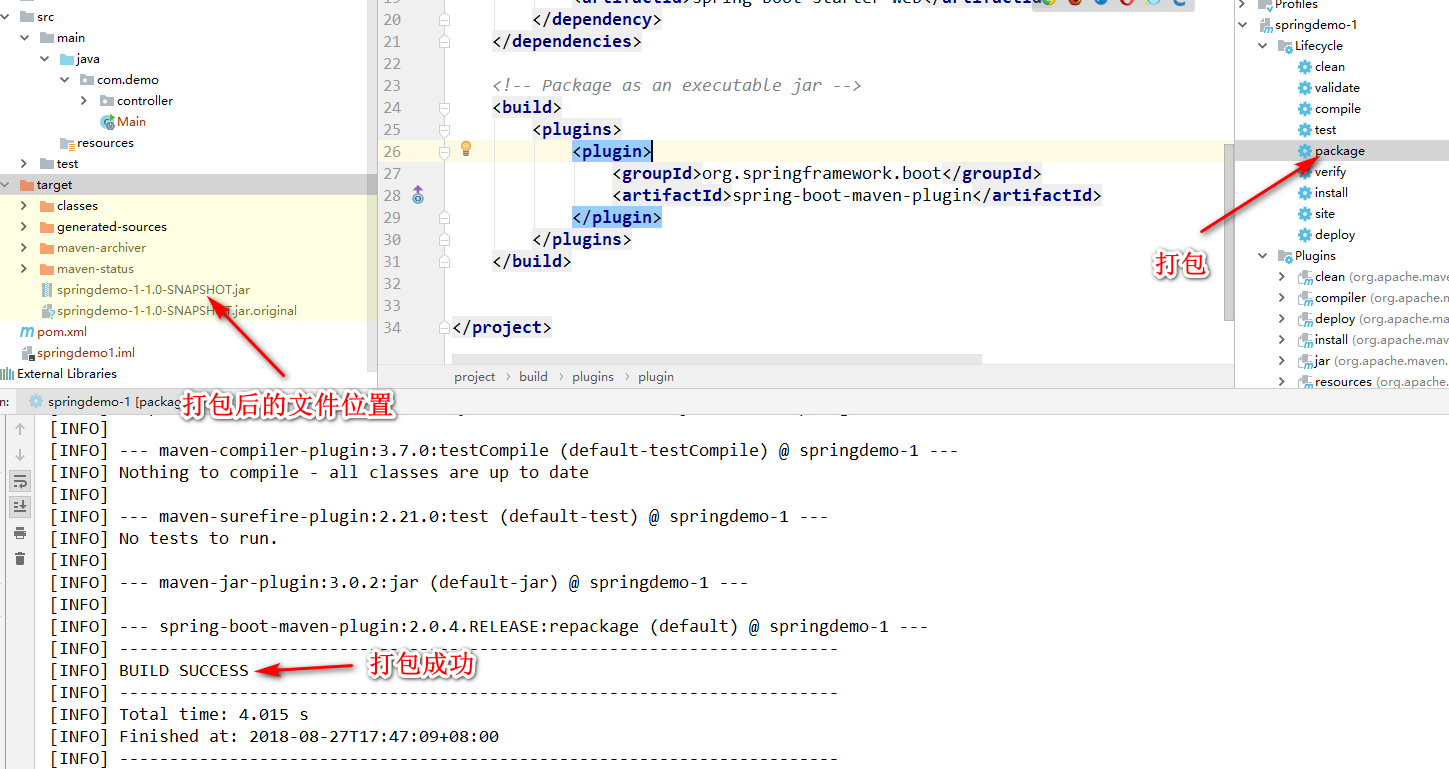
用java命令运行,访问http://127.0.0.1:8080/hello就可以看到效果
java -jar jar文件路径
二、HelloWorldj简单分析
1.pom.xml文件
<parent>
<groupId>org.springframework.boot</groupId>
<artifactId>spring-boot-starter-parent</artifactId>
<version>2.0.4.RELEASE</version>
</parent>
里面引用了,它是真正管理SpringBoot里面所有依赖jar包的版本
以后导入依赖默认是不需要写版本,里面没有的依赖才需要声明版本号
<parent>
<groupId>org.springframework.boot</groupId>
<artifactId>spring-boot-dependencies</artifactId>
<version>2.0.4.RELEASE</version>
<relativePath>../../spring-boot-dependencies</relativePath>
</parent>
spring-boot-starter:spring-boot场景启动器
spring-boot-starter-web:帮我们导入了web模块正常运行所依赖的组件
<dependency>
<groupId>org.springframework.boot</groupId>
<artifactId>spring-boot-starter-web</artifactId>
</dependency>
Spring Boot将所有的功能场景都抽取出来,做成一个个的starters(启动器)
要用什么功能就导入什么场景的启动器,相关依赖会自动导入
2.启动类
@SpringBootApplication
public class Main {
public static void main(String[] args) {
SpringApplication.run(Main.class,args);
}
}
@SpringBootApplication:标注在某个类上说明这个类是SpringBoot的主配置类,SpringBoot就应该运行这个类的main方法来启动SpringBoot应用;
查看SpringBootApplication注解
@Target(ElementType.TYPE)
@Retention(RetentionPolicy.RUNTIME)
@Documented
@Inherited
@SpringBootConfiguration //Spring Boot配置类,里面有@Configuration注解,类似以前的xml配置
@EnableAutoConfiguration //开启自动配置功能
@ComponentScan(excludeFilters = {
@Filter(type = FilterType.CUSTOM, classes = TypeExcludeFilter.class),
@Filter(type = FilterType.CUSTOM, classes = AutoConfigurationExcludeFilter.class) })
public @interface SpringBootApplication {
查看 @EnableAutoConfiguration 注解
@Target(ElementType.TYPE)
@Retention(RetentionPolicy.RUNTIME)
@Documented
@Inherited
@AutoConfigurationPackage //自动配置包
@Import(AutoConfigurationImportSelector.class) //导入配置选择器
public @interface EnableAutoConfiguration {
查看 AutoConfigurationImportSelector.class 类,Debug运行
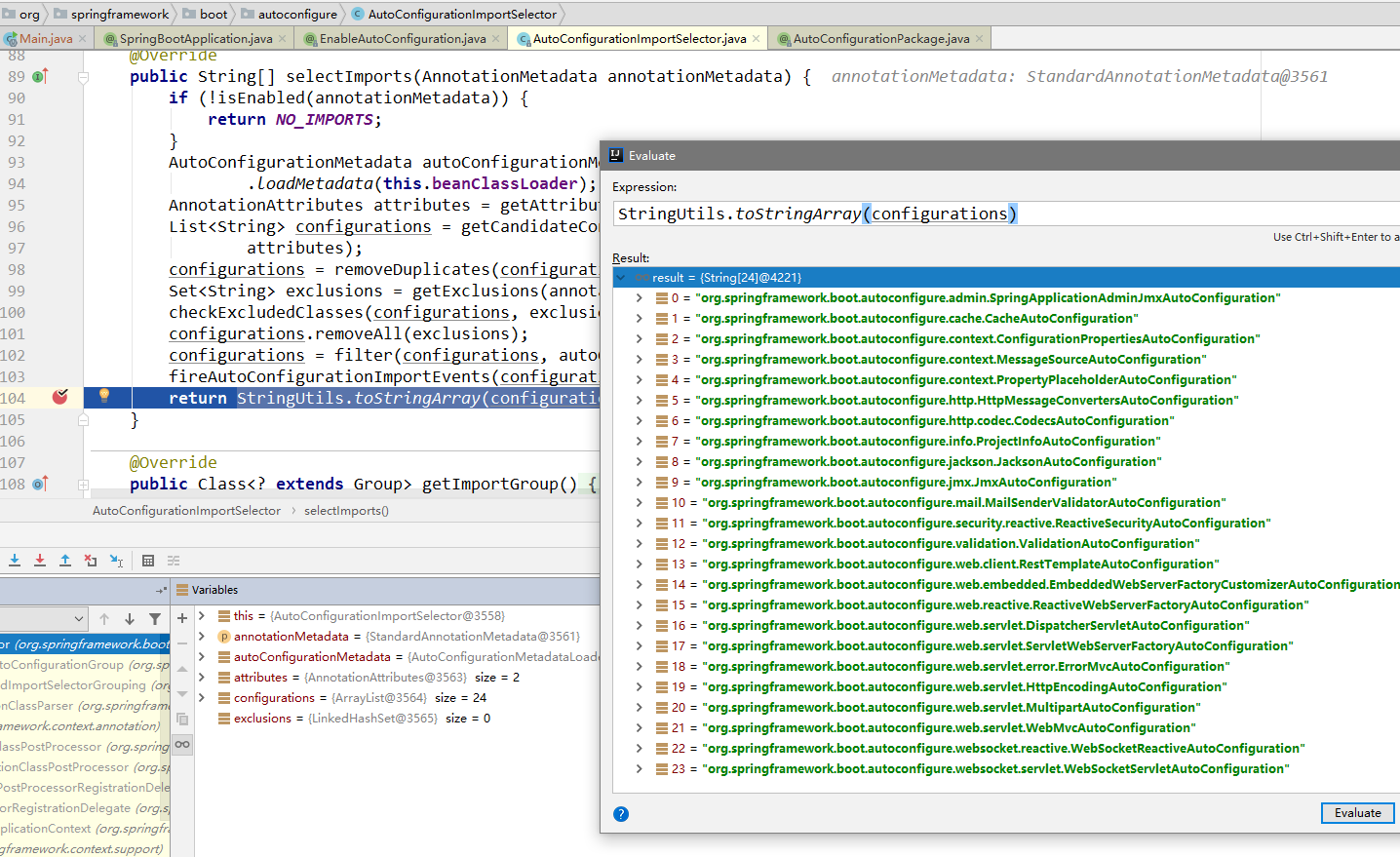
可以看到我们之所以不用写配置文件是应为SpringBoot帮我们导入了许多自动配置类,那么这些配置类从哪来,点进去可以看到有个自动配置包
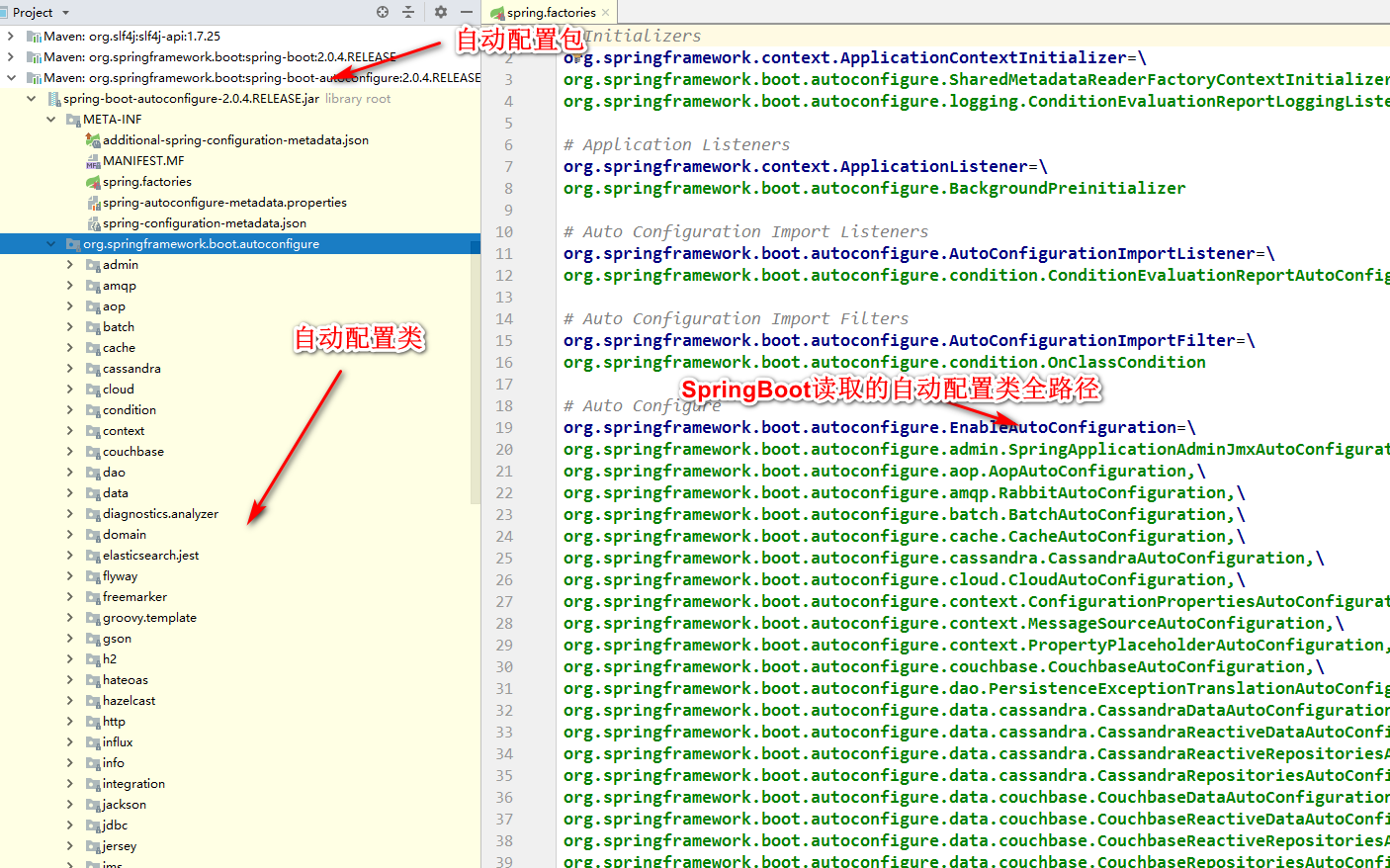
查看 @AutoConfigurationPackage 注解
@Target(ElementType.TYPE)
@Retention(RetentionPolicy.RUNTIME)
@Documented
@Inherited
@Import(AutoConfigurationPackages.Registrar.class)
public @interface AutoConfigurationPackage {
查看 AutoConfigurationPackages.Registrar.class 类,Debug运行
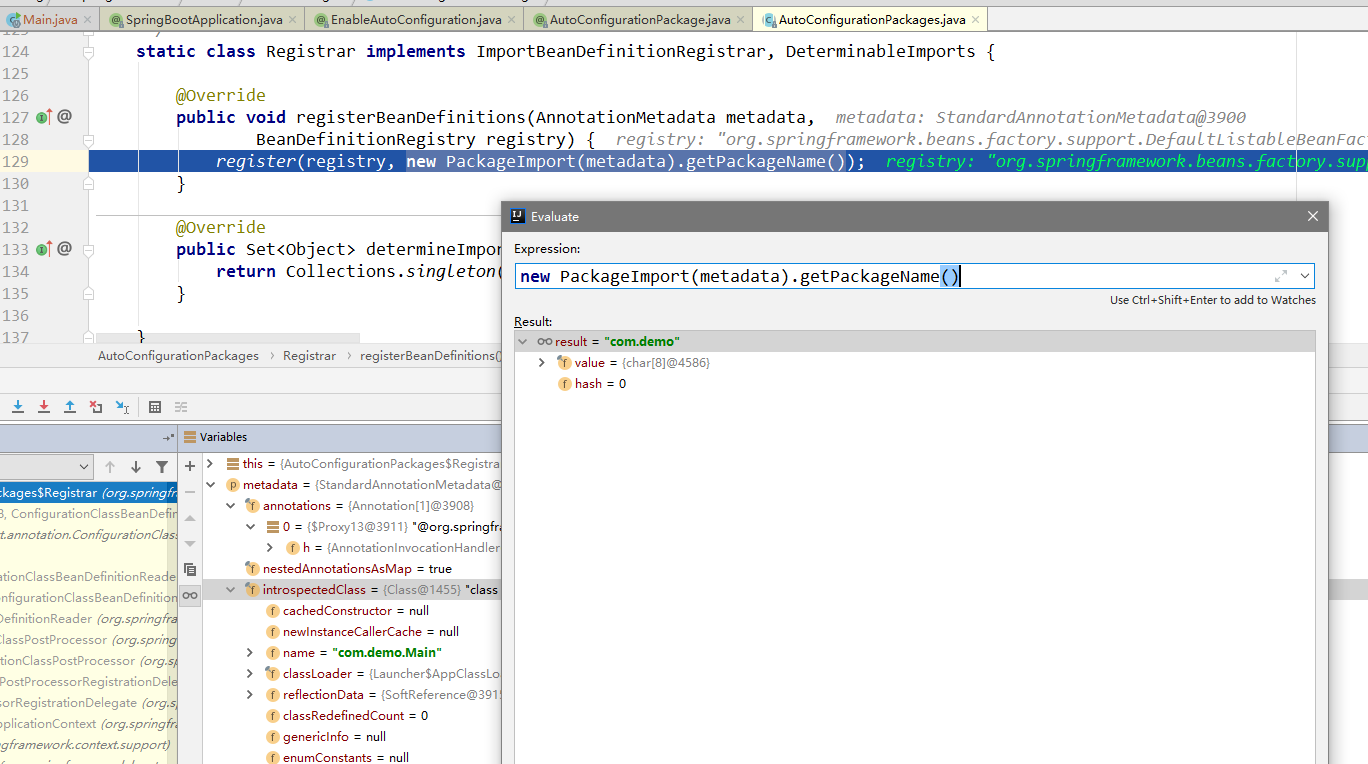
可以看到会拿到启动类所在包名,它会将此包及下面所有子包里面的所有组件扫描到Spring容器中
三、使用Spring Initializer快速创建Spring Boot项目
1.IDEA使用Spring的项目创建向导快速创建一个Spring Boot项目,选择我们需要的模块;向导会联网创建Spring Boot项目
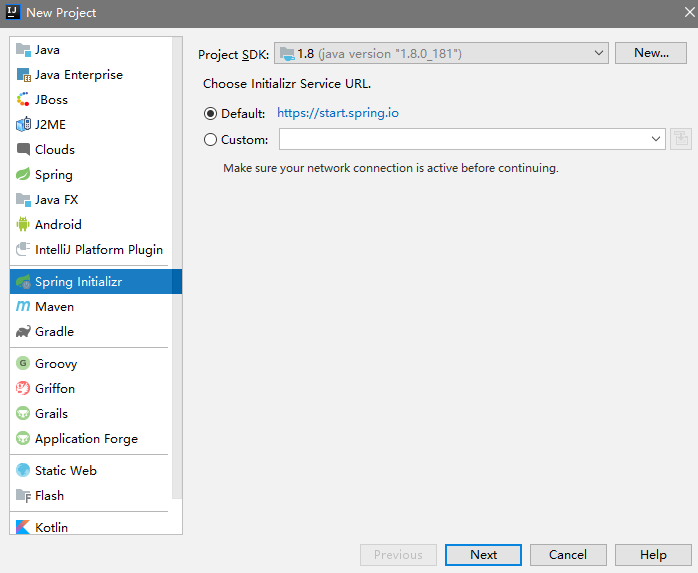
默认生成的Spring Boot项目
- 主程序已经生成好了,我们只需要我们自己的逻辑
- resources文件夹中目录结构
- static:保存所有的静态资源; js css images;
- templates:保存所有的模板页面;(Spring Boot默认jar包使用嵌入式的Tomcat,默认不支持JSP页面);可以使用模板引擎(freemarker、thymeleaf);
- application.properties:Spring Boot应用的配置文件;可以修改一些默认设置;
2.STS使用 Spring Starter Project快速创建项目
四、配置文件
SpringBoot使用一个全局的配置文件,配置文件名是固定的;
•application.properties
•application.yml
配置文件的作用:修改SpringBoot自动配置的默认值
1、ymal语法
k:(空格)v 表示一对键值对
以空格的缩进来控制层级关系;只要是左对齐的,都是同一个层级,属性和值都大小写敏感
server:
port: 8081
path: /hello
1.1、字面量:普通的值(数字,字符串,布尔)
字符串默认不用加上单引号或者双引号
# "":双引号不会转义字符串里面的特殊字符,特殊字符会作为本身想表示的意思
# 输出;zhangsan 换行 lisi
name: "zhangsan \n lisi"
# '':单引号会转义特殊字符,特殊字符最终只是一个普通的字符串数据
# 输出;zhangsan \n lisi
name: ‘zhangsan \n lisi’
1.2、对象、Map(属性和值)(键值对)
friends:
lastName: zhangsan
age: 20
# 行内写法
friends: {lastName: zhangsan,age: 18}
1.3、数组(List、Set):
pets:
- cat
- dog
- pig
# 行内写法
pets: [cat,dog,pig]
1.4、配置文件值注入
# 配置文件
person:
lastName: hello
age: 18
boss: false
birth: 2017/12/12
maps: {k1: v1,k2: 12}
lists:
- lisi
- zhaoliu
dog:
name: 小狗
age: 12
/**
* 将配置文件中配置的每一个属性的值,映射到这个 javaBean 组件中
* @ConfigurationProperties:告诉SpringBoot将本类中的所有属性和配置文件中相关的配置进行绑定
* prefix = "person":配置文件中哪个下面的所有属性进行一一映射
* 只有这个组件是容器中的组件,才能容器提供的@ConfigurationProperties功能
*/
@Component
@ConfigurationProperties(prefix = "person")
public class Person {
private String lastName;
private Integer age;
private Boolean boss;
private Date birth;
private Map<String,Object> maps;
private List<Object> lists;
private Dog dog;
<!--导入配置文件处理器,配置文件进行绑定就会有提示-->
<dependency>
<groupId>org.springframework.boot</groupId>
<artifactId>spring-boot-configuration-processor</artifactId>
<optional>true</optional>
</dependency>
2、properties语法
2.1、@Value获取值和@ConfigurationProperties获取值比较
| @ConfigurationProperties | @Value | |
|---|---|---|
| 功能 | 批量注入配置文件中的属性 | 一个个指定 |
| 松散绑定(松散语法) | 支持 | 不支持 |
| SpEL | 不支持 | 支持 |
| JSR303数据校验 | 支持 | 不支持 |
| 复杂类型封装 | 支持 | 不支持 |
只是在某个业务逻辑中需要获取一下配置文件中的某项值,使用@Value,专门编写了一个javaBean来和配置文件进行映射,就使用@ConfigurationProperties
# 配置文件注入值数据校验
@Component
@ConfigurationProperties(prefix = "person")
@Validated
public class Person {
//lastName必须是邮箱格式
@Email
//@Value("${person.last-name}")
private String lastName;
//@Value("#{11*2}")
private Integer age;
//@Value("true")
private Boolean boss;
2.2、@PropertySource、@ImportResource、@Bean
2.2.1、@PropertySource:加载指定的配置文件
/**
* @ConfigurationProperties:将本类中的所有属性和 全局配置文件 中相关的配置进行绑定
* prefix = "person":配置文件中哪个下面的所有属性进行一一映射
* 只有这个组件是容器中的组件,才能容器提供的@ConfigurationProperties功能;
*/
@Component
@ConfigurationProperties(prefix = "person")
@PropertySource(value = {"classpath:person.properties"})
public class Person {
//@Value("${person.last-name}")
private String lastName;
//@Value("#{11*2}")
private Integer age;
//@Value("true")
private Boolean boss;
2.2.2、@ImportResource:导入Spring的xml配置文件
想让Spring的xml配置文件生效,在一个配置类上标注@ImportResource
# 导入Spring的xml配置文件让其生效
@ImportResource(locations = {"classpath:beans.xml"})
<!--beans.xml -->
<?xml version="1.0" encoding="UTF-8"?>
<beans xmlns="http://www.springframework.org/schema/beans"
xmlns:xsi="http://www.w3.org/2001/XMLSchema-instance"
xsi:schemaLocation="http://www.springframework.org/schema/beans http://www.springframework.org/schema/beans/spring-beans.xsd">
<bean id="helloService" class="com.atguigu.springboot.service.HelloService"></bean>
</beans>
2.2.2、@Bean:导入JavaBean配置
// @Configuration:指明当前类是一个配置类
@Configuration
public class MyAppConfig {
//将方法的返回值添加到容器中,容器中这个组件默认的id就是方法名
@Bean
public HelloService helloService02(){
System.out.println("配置类@Bean给容器中添加组件了...");
return new HelloService();
}
}
2.3、配置文件占位符
2.3.1、随机数
${random.value}
${random.int}
${random.long}
${random.int(10)}
${random.int[1024,65536]}
2.3.2、占位符获取之前配置的值,如果没有可以是用:指定默认值
person.last-name=张三${random.uuid}
person.age=${random.int}
person.birth=2017/12/15
person.boss=false
person.dog.name=${person.hello:hello}_dog
person.dog.age=15
3、多配置环境切换
3.1、多Profile文件
主配置文件名可以是 application-{profile}.properties/yml,默认使用application.properties的配置
在application.properties配置文件中来指定环境
spring.profiles.active=dev
3.2、yml支持多文档块方式
server:
port: 8081
spring:
profiles:
active: prod #指定使用哪个环境
---
server:
port: 8083
spring:
profiles: dev #指定属于哪个环境
---
server:
port: 8084
spring:
profiles: prod #指定属于哪个环境
3.3、其他方式激活指定profile
1、命令行,可以直接在测试的时候,配置传入命令行参数
java -jar spring-boot-02-config-0.0.1-SNAPSHOT.jar –spring.profiles.active=dev
2、虚拟机参数 (VM options)
-Dspring.profiles.active=dev
4、配置文件加载位置
4.1、内部配置加载顺序
springboot 启动会扫描以下位置的application.properties或者application.yml文件作为Spring boot的默认配置文件
–file:./config/
–file:./
–classpath:/config/
–classpath:/
优先级由高到底,高优先级的配置会覆盖低优先级的配置;
SpringBoot会从这四个位置全部加载主配置文件;互补配置
项目打包好以后,我们可以使用命令行参数的形式,启动项目的时候来指定配置文件的新位置,指定配置文件和默认加载的这些配置文件共同起作用形成互补配置
java -jar xxxx.jar --spring.config.location=G:/application.properties
4.2、外部配置加载顺序
SpringBoot也可以从以下位置加载配置; 优先级从高到低,高优先级的配置覆盖低优先级的配置,所有的配置会形成互补配置
1.命令行参数,所有的配置都可以在命令行上进行指定,多个配置用空格分开; –配置项=值
java -jar spring-boot-02-config-02-0.0.1-SNAPSHOT.jar –server.port=8087 –server.context-path=/abc
2.来自java:comp/env的JNDI属性
3.Java系统属性(System.getProperties())
4.操作系统环境变量
5.RandomValuePropertySource配置的random.*属性值
(6、7、8、9)总结为:由jar包外向jar包内进行寻找,优先加载带profile,再来加载不带profile
6.jar包外部的application-{profile}.properties或application.yml(带spring.profile)配置文件
7.jar包内部的application-{profile}.properties或application.yml(带spring.profile)配置文件
8.jar包外部的application.properties或application.yml(不带spring.profile)配置文件
9.jar包内部的application.properties或application.yml(不带spring.profile)配置文件
10.@Configuration注解类上的@PropertySource
11.通过SpringApplication.setDefaultProperties指定的默认属性
所有支持的配置加载来源:参考官方文档
配置文件可以配置的选项:配置文件能配置的属性参照
五、自动配置原理浅析
5.1、上面分析时说了在启动时会导入许多自动配置类,这里以HttpEncodingAutoConfiguration(Http编码自动配置)来分析,看干了什么
@Configuration //表示是一个配置类,和以前编写的配置文件一样,也可以给容器中添加组件
@EnableConfigurationProperties(HttpEncodingProperties.class) //启动指定类的ConfigurationProperties功能,将配置文件中对应的值和HttpEncodingProperties绑定起来;并把HttpEncodingProperties加入到ioc容器中
@ConditionalOnWebApplication(type = ConditionalOnWebApplication.Type.SERVLET) //Spring底层@Conditional注解,根据不同的条件来确定是否添加到容器中,判断当前应用是否是web应用,如果是,当前配置类生效
@ConditionalOnClass(CharacterEncodingFilter.class) //判断当前项目有没有这个类CharacterEncodingFilter,它是SpringMVC中进行乱码解决的过滤器
@ConditionalOnProperty(prefix = "spring.http.encoding", value = "enabled", matchIfMissing = true) //判断配置文件中是否存在某个配置 spring.http.encoding.enabled;如果不存在,判断也是成立的,即使我们配置文件中不配置pring.http.encoding.enabled=true,也是默认生效的;
public class HttpEncodingAutoConfiguration {
//SpringBoot的配置文件的映射类
private final HttpEncodingProperties properties;
//只有一个有参构造器的情况下,参数的值就会从容器中拿
public HttpEncodingAutoConfiguration(HttpEncodingProperties properties) {
this.properties = properties;
}
@Bean //给容器中添加一个组件,这个组件的某些值需要从properties中获取
@ConditionalOnMissingBean //判断容器是否没有这个组件
public CharacterEncodingFilter characterEncodingFilter() {
CharacterEncodingFilter filter = new OrderedCharacterEncodingFilter();
filter.setEncoding(this.properties.getCharset().name());
filter.setForceRequestEncoding(this.properties.shouldForce(Type.REQUEST));
filter.setForceResponseEncoding(this.properties.shouldForce(Type.RESPONSE));
return filter;
}
@Bean
public LocaleCharsetMappingsCustomizer localeCharsetMappingsCustomizer() {
return new LocaleCharsetMappingsCustomizer(this.properties);
}
private static class LocaleCharsetMappingsCustomizer implements WebServerFactoryCustomizer<ConfigurableServletWebServerFactory>, Ordered {
private final HttpEncodingProperties properties;
LocaleCharsetMappingsCustomizer(HttpEncodingProperties properties) {
this.properties = properties;
}
@Override
public void customize(ConfigurableServletWebServerFactory factory) {
if (this.properties.getMapping() != null) {
factory.setLocaleCharsetMappings(this.properties.getMapping());
}
}
@Override
public int getOrder() {
return 0;
}
}
}
@ConfigurationProperties(prefix = "spring.http.encoding") //从配置文件中获取指定的值和bean的属性进行绑定
public class HttpEncodingProperties {
public static final Charset DEFAULT_CHARSET = StandardCharsets.UTF_8;
5.2、总结:
1)、SpringBoot启动会加载大量的自动配置类
2)、我们看我们需要的功能有没有SpringBoot默认写好的自动配置类
3)、我们再来看这个自动配置类中到底配置了哪些组件,(只要我们要用的组件有,我们就不需要再来配置了)
4)、给容器中自动配置类添加组件的时候,会从properties类中获取某些属性。我们就可以在配置文件中指定这些属性的值,xxxxAutoConfigurartion:自动配置类,给容器中添加组件,xxxxProperties:封装配置文件中相关属性
5.3、附:@Conditional派生注解,作用:必须是@Conditional指定的条件成立,才给容器中添加组件,配置配里面的所有内容才生效
| @Conditional扩展注解 | 作用(判断是否满足当前指定条件) |
|---|---|
| @ConditionalOnJava | 系统的java版本是否符合要求 |
| @ConditionalOnBean | 容器中存在指定Bean; |
| @ConditionalOnMissingBean | 容器中不存在指定Bean; |
| @ConditionalOnExpression | 满足SpEL表达式指定 |
| @ConditionalOnClass | 系统中有指定的类 |
| @ConditionalOnMissingClass | 系统中没有指定的类 |
| @ConditionalOnSingleCandidate | 容器中只有一个指定的Bean,或者这个Bean是首选Bean |
| @ConditionalOnProperty | 系统中指定的属性是否有指定的值 |
| @ConditionalOnResource | 类路径下是否存在指定资源文件 |
| @ConditionalOnWebApplication | 当前是web环境 |
| @ConditionalOnNotWebApplication | 当前不是web环境 |
| @ConditionalOnJndi | JNDI存在指定项 |
5.4、查看生效的自动配置类
# application.yml
debug=true
# 控制台输出日志
=========================
AUTO-CONFIGURATION REPORT(自动配置报告)
=========================
Positive matches:(自动配置类启用的)
-----------------
DispatcherServletAutoConfiguration matched:
- @ConditionalOnClass found required class 'org.springframework.web.servlet.DispatcherServlet'; @ConditionalOnMissingClass did not find unwanted class (OnClassCondition)
- @ConditionalOnWebApplication (required) found StandardServletEnvironment (OnWebApplicationCondition)
Negative matches:(没有启动,没有匹配成功的自动配置类)
-----------------
ActiveMQAutoConfiguration:
Did not match:
- @ConditionalOnClass did not find required classes 'javax.jms.ConnectionFactory', 'org.apache.activemq.ActiveMQConnectionFactory' (OnClassCondition)
AopAutoConfiguration:
Did not match:
- @ConditionalOnClass did not find required classes 'org.aspectj.lang.annotation.Aspect', 'org.aspectj.lang.reflect.Advice' (OnClassCondition)